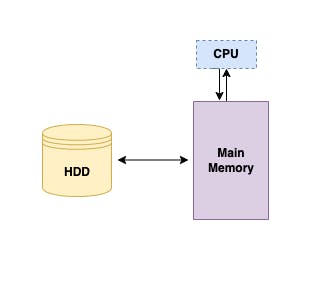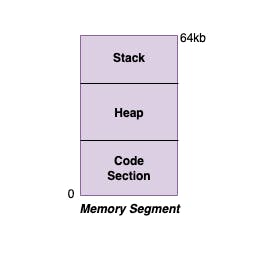
Photo by Cookie the Pom on Unsplash
Memory Allocation in Programming 101
Understanding the Stack, Heap and Code Sections of a Program
Introduction
As a software developer, you may have heard of the terms Stack, Heap and Code Section. These are three important sections of a running program, and understanding them is essential to writing efficient and effective code.
In this post, I'll explain what each of these sections does and how dynamic and static memory allocation fit into that.
First, let's take a look at a Basic Computer Architecture
A computer is made up of several components, including the RAM, the hard disk, and the processor. Each of these components plays a role when a program is running.
The RAM is the computer's short-term memory; the hard disk is a type of permanent storage for the computer and this is where a program and files are stored; and the processor is the "brain" of the computer, it executes the instructions in the program and performs calculations.
When a program is launched, it is loaded from the hard disk into the RAM so that the processor can access it quickly. The RAM is typically divided into segments of 64kb in size, and each of these segments is divided into three sections: the Stack, the Heap and the Code Section.
Everything we talk about in this blog post regarding memory allocation is all happening in the context of these segments inside of the RAM.
The Code Section
The Code Section contains the instructions that the processor executes. Think of it as a recipe book for the computer. These instructions define the behavior of the program and are typically fixed in size.

The Code Section is read-only and is typically located at the beginning of the program's memory space. It is shared by all instances of the program and is loaded into memory at program startup.
The Stack
The Stack is used for local variables and function calls. Each time a function is called, the program pushes the function's arguments and local variables onto the stack and pops them off the stack when the function returns.

Think of it as a stack of plates at a buffet. Each time you take a plate, you add it to the top of the stack. When you're done eating, you start at the top of the stack and work your way down. The size of the stack is limited so if you try to add too many plates, some of them will fall off, similarly, the size of the stack is typically fixed at compile time and does not change during the program's execution.
The Stack is a Last-In-First-Out (LIFO) data structure, meaning that the last variable or function call to be pushed onto the stack is the first to be popped off. This makes it useful for managing function calls and storing temporary variables.
The Heap
The Heap is used for dynamic memory allocation. Think of it as a storage unit where you can rent space as you need it. When you need to store something, you rent a space in the storage unit. When you're done with it, you return the space and stop paying rent.

Similarly, when the program needs to allocate memory dynamically (i.e., at runtime), it requests memory from the operating system's heap. The size of the heap can grow and shrink during the program's execution as memory is allocated and deallocated.
The Heap is a more flexible data structure than the Stack, as it allows for the allocation and deallocation of memory at runtime. This makes it useful for managing data structures of variable sizes, such as arrays and linked lists.
Dynamic vs. Static Memory Allocation
Now, let's talk about how dynamic and static memory allocation fit into the Stack, Heap, and Code sections of a program.
Static memory allocation is typically used for variables and data structures with a fixed size, and these are typically stored in the Stack section of the program. For example, a statically allocated array or struct would be stored in the Stack.
Dynamic memory allocation, on the other hand, is used for variables and data structures with variable size, and these are typically stored in the Heap section of the program. For example, if a program needs to read data from a file of unknown length, it might allocate a buffer on the Heap and store the data as it is read.
Dynamic memory allocation can be more versatile than static memory allocation, as it allows programs to allocate memory on the fly, but it can also be slower and more error-prone. Static memory allocation is faster and simpler, but it requires the programmer to know the size of the data structures at compile time.
Conclusion
In conclusion, the Stack, Heap, and Code sections of a program serve different purposes and are used for different types of data. Static memory allocation is typically used for variables and data structures with a fixed size, while dynamic memory allocation is used for variables and data structures with a variable size. Understanding the differences between these memory allocation techniques and the Stack, Heap, and Code sections of a program is essential to writing efficient and effective code.



